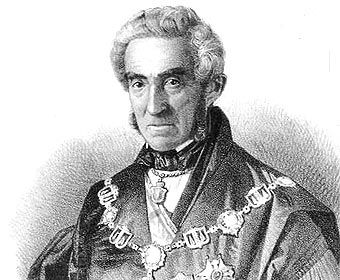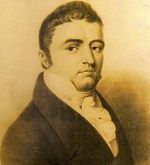Lorenzo Arrazola y GarcÃa
Lorenzo Arrazola y Garcia ( born August 10, 1797 in Checa ( Guadalajara province ); † February 23, 1873 in Madrid) was a Spanish jurist, politician and President of the Government of Spain (Presidente del Gobierno ).
- 2.1 External links
- 2.2 Notes and references
Biography
Study and career
Hailing from a poor family Arrazola was able to complete with the help of an uncle, the bailiff of Checa, studied philosophy and theology in a seminary. Before concluding his studies he began then, however, a study of the law, which he finished later with a Doctor of Law. After graduating, he was appointed to the chair of law, philosophy and rhetoric at the University of Valladolid, whose rector he was later also. Then in 1835 he was appointed to the litigator ( Procurator ) of Valladolid.
Arrazola was also published the 1848-1870 twelve-volume " Enciclopedia Española de derecho " ( Encyclopedia of the Spanish law ), which was an important standard work on the law of Spain of this era. However, the encyclopedia included at the end of the 1870 edition only entries to the letter C. In addition, he was also the author of the book " Truth Be Told Filosofía para uso de la juventud " (Handbook of Philosophy for Youth ).
MP, Minister and President of the Supreme Court
His political career began then on 22 September 1837 the election of the Members of Parliament ( Congreso de los Deputies ), where he initially for three legislatures until February 1841 represented the interests of the constituency of Valladolid. From the first moment of his political career, he found his political base in the ideology of the Partido Moderado.
After just one year membership Parliament he was on 9 December 1838 Minister for clemency petitions and Justice ( Ministro de Gracia y Justicia ) appointed to the Cabinet of Evaristo Pérez de Castro Brito, where he remained until July 20, 1840. During this time he was at times in May and in October-November 1839 Office of the Minister of the Interior ( Ministro de Gobernación ). On 3 September 1844, he was re-elected Members of Parliament and this time was for two terms until August 1850 representatives of the constituencies of Valladolid and Zamora. From February 13 until March 16, 1846, he served as Minister of Justice appeals for clemency and was member of the Cabinet of Manuel Pando Fernández de Pinedo.
As Minister of appeals for clemency and justice, he was one of 4 October 1847 to January 14, 1851 for the fourth and fifth cabinet of Ramón María Narváez on. His tenure as Prime Minister was interrupted only by the office located in the only twenty-seven hours caretaker cabinet of Serafín María de Soto from 19 to 20 October 1849. One important result of his ministers activity was the adoption of the Criminal Code of 1848 ( Codigo Penal ).
For his political services he ( Senador Vitalicio ) was then on December 23, 1848 by decree of Queen Isabella II to the appointed senator for life.
Following the resignation as justice minister, he was appointed in 1851 as President of the Supreme Court (Tribunal Supremo ), which he headed until 1853 initially. Between 1856 and 1864 he was again president of the Supreme Court. In between, he served as Attorney General ( Procurator General ). During his tenure as president there were a Royal Decree of 17 January 1854, the tasks of the Chamber of Spanish East Indies ( Sala de Indias ) is transferred to the other two chambers. However, this decision was reversed after the Revolution of 1868 (La Gloriosa ) by the Provisional Law of 1870. On the other hand, since 1863 a comprehensive reform of the Supreme Court: The reform of the civil Kassatorischen decisions, the introduction of criminal Kassationsgerichten and in particular the reorganization of the Supreme Court with a president, five vice presidents who presided over the past five chambers for civil and criminal decisions and 31 judges. This division is largely even today.
President of the Government and final years
After he had held more than ten years in the political background, he was appointed on January 17, 1864 even President of the Government of Spain (Presidente del Gobierno ) and took over at the same time the Minister of Foreign Affairs ( Ministro de Estado ). However, his tenure lasted only until its replacement by Alejandro Mon Menendez on 1 March 1864.
After the replacement of Mon Menéndez on September 16, 1864, he was re-appointed as Minister of appeals for clemency and justice in its sixth Cabinet by the successor Narváez, where he remained until June 21, 1865. During this time he was also for a few days in September 1864 Acting Colonial Secretary ( Ministro de Ultramar ) and in April to May and in June 1865 Acting Secretary of State.
On July 10, 1866 he was appointed as Minister of Narváez again for clemency and justice in his seventh cabinet. On 27 June 1867 he was appointed as part of a cabinet reshuffle as Foreign Minister and held that office until the end of Narváez term of office on 23 April 1868.
Honorary appointments and awards
On 21 May 1832 he was appointed a member of the Royal Academy of Fine Arts of San Fernando (Real Academia de la Purisima Concepcion de Valladolid).
On September 29, 1857, he was one of the 36 founding members of the Real Academia de Ciencias Morales y Politicas and took there until January 18, 1870, the chair 2. Between 20 February 1866 and 18 November 1868, he was also also president of the Academy.
For his political and scientific work, he was awarded, among others, in 1868 with the Order of the Golden Fleece ( Orden del Toison de Oro ).










